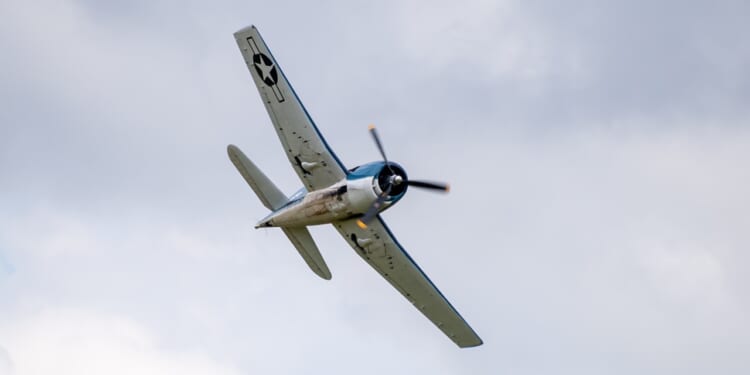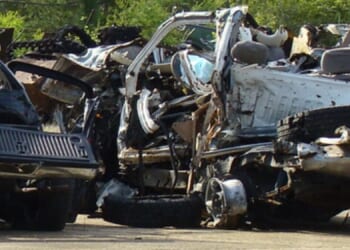The Hellcat’s forgiving flight characteristics and durability allowed less experienced pilots to survive early engagements and gain greater experience against the Japanese Mitsubishi A6M Zero.
The Grumman F6F Hellcat was a carrier-based fighter developed by the United States to wage war against Imperial Japan during World War II. It was the American answer to Japan’s notorious Mitsubishi A6M Zero, against which the United States had few countermeasures in the first years of the war.
Entering frontline service in September 1943 aboard the USS Yorktown, the F6F Hellcat became the Navy’s dominant fighter, replacing the earlier F4F Wildcat. And the Hellcat quickly proved its worth; over the course of the war, Hellcat pilots were credited with destroying a whopping 5,223 enemy aircraft while suffering only 270 losses in air-to-air combat—an impressive 19:1 kill ratio. This tally accounted for about 75 percent of all aerial victories by US Navy and Marine Corps pilots in the Pacific Theater, with 305 Hellcat pilots achieving “ace” status (five or more kills).
The Hellcat Was Built to Counter Japan’s Zero Fighter
| Aircraft | Grumman F6F Hellcat (USA) | Mitsubishi A6M Zero (Japan) |
| Year Introduced | 1943 | 1940 |
| Number Built | 12,275 (1942-1945) | 10,939 (1940-1945) |
| Length | 33 ft 7 in (10.24 m) | 29 ft 9 in (9.06 m) |
| Wingspan | 42 ft 10 in (13.06 m) | 39 ft 4 in (12 m) |
| Weight (MTOW) | 15,415 lb | 6,164 lb (2,796 kg) |
| Engines | One Pratt & Whitney R-2800-10W Double Wasp 18-cylinder air-cooled radial piston engine, 2,200 hp (1,600 kW) | One Nakajima NK1C Sakae-12 14-cylinder air-cooled radial piston engine, 700 kW (940 hp) |
| Top Speed | 391 mph (629 km/h) | 331 mph (533 km/h) |
| Combat Range | 945 mi (1,521 km) | 1,160 mi (1,870 km) |
| Service Ceiling | 37,300 ft (11,400 m) | 33,000 ft (10,000 m) |
| Loadout | Six .50 caliber M2 Browning machine guns, or two 20mm AN/M2 cannons and four .50 caliber M2 Browning machine guns; six 5-inch (or two 11.75-inch) unguided rockets; up to 4,000 lb (1,814 kg) bomb capacity | Two 7.7mm Type 97 machine guns; two 20mm cannons; two 60 kg (130 lb) bombs; additional bombs on kamikaze missions |
| Aircrew | 1 | 1 |
The F6F was engineered with direct input from combat lessons learned, often painfully, during the early war. These lessons learned included information gleaned from American intelligence’s capture of several Japanese Zeroes. Grumman prioritized ruggedness, firepower, and pilot protection over extreme agility in the Hellcat’s design.
This bird had a powerful 2,000-horsepower Pratt & Whitney R-2800 Double Wasp radial engine, enabling a top speed of around 380 miles per hour and an excellent climb rate. These planes had an armament of six .50-caliber machine guns, plus the ability to carry bombs, rockets, or drop tanks for extended range. An armored cockpit, self-sealing fuel tanks, and a sturdy airframe that could take a wallop and still return its pilot safely to base were defining features. The superior high-speed handling and dive performance allowed pilots to dictate engagements by dropping in from above and zooming away if needed.
The Hellcat was designed with one overarching adversary in mind: Japan’s Zero fighter, which had terrorized American forces in the Pacific for nearly two years. Indeed, the Hellcat was built to counter the Zero; while the Japanese plane was lighter and more maneuverable at slower speeds, the Hellcat outperformed it in most practical combat scenarios, especially at higher altitudes and speeds where dogfights tended to occur.
From 1942 to 1945, Grumman produced over 12,275 Hellcats, allowing for rapid deployment across US carrier task forces. This massive output ensured numerical superiority in key battles. The aircraft’s reliability and ease of maintenance made it ideal for carrier operations, with a wide landing gear stance than reduced accidents on pitching decks.
The Hellcat Crippled Japan’s Air Force Over the Pacific
The Hellcat arrived when the tide of war was turning against the Axis Powers. By mid-1943, Japan’s elite pilots from earlier campaigns had been largely depleted through attrition, and their replacements were rushed through training with limited fuel and resources. In contrast, US pilots benefited from advanced training, radar-directed intercepts, and superior intelligence.
Major engagements highlighted the Hellcat’s impeccable World War II performance. During the Battle of the Philippine Sea in June 1944—sometimes described as the “Great Marianas Turkey Shoot” because of the advantage the Americans held—Hellcats from Task Force 58 shot down over 300 Japanese planes in a single day with few losses, crippling Japan’s carrier air arm. In the later Battle of Leyte Gulf (October 1944), Hellcats provided air cover and strikes, with notable acts of heroism, like Commander David McCampbell downing nine planes in one sortie.
During these engagements, US tactics emphasized hit-and-run attacks, using the Hellcat’s speed and firepower to avoid prolonged dogfights where the Zero’s maneuverability gave it an edge. Night-fighter Hellcat variants (F6F-5N) with onboard radar further extended its reach.
Beyond the machine itself, skilled aviators like McCampbell and others maximized the plane’s potential. The Hellcat’s forgiving flight characteristics and durability allowed less experienced pilots to survive early engagements and gain greater experience. Postwar analyses suggest the “dark truth” behind the high kill ratio was partly due to facing increasingly inferior opposition from the Japanese, but the Hellcat’s design ensured it capitalized on every advantage.
The F6F’s combination of engineering excellence, timely introduction, and overwhelming deployment made sure this bird would be a total war-winner—outclassing Japanese fighters and contributing decisively to Allied air superiority in the Pacific.
About the Author: Brandon J. Weichert
Brandon J. Weichert is a senior national security editor at The National Interest. Recently, Weichert became the host of The National Security Hour on America Outloud News and iHeartRadio, where he discusses national security policy every Wednesday at 8pm Eastern. He is also a contributor at Popular Mechanics and has consulted regularly with various government institutions and private organizations on geopolitical issues. Weichert’s writings have appeared in multiple publications, including The Washington Times, National Review, The American Spectator, MSN, The Asia Times, and others. His books include Winning Space: How America Remains a Superpower, Biohacked: China’s Race to Control Life, and The Shadow War: Iran’s Quest for Supremacy. His newest book, A Disaster of Our Own Making: How the West Lost Ukraine is available for purchase wherever books are sold. He can be followed via Twitter @WeTheBrandon.
Image: Shutterstock / C-S.

















